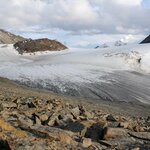Oceanography

We know some glaciers are growing and we know some glaciers are receding. What we did not know until recently is how many glaciers there are, where they are, and what their extents and volumes are.
That has changed - for the first time reliable calculations of the future development of glaciers and their contributions to regional hydrology and global sea-level rise can be derived from an accurate measurement.
The international team mapped all of the world’s glaciers so all glaciologists can study the impacts of a changing climate on glaciers worldwide, and determine their total extent…

The melting of a rather small ice volume on East Antarctica's shore could trigger a persistent ice discharge into the ocean, resulting in unstoppable sea-level rise for thousands of years to come, according to computer simulations of the Antarctic ice flow by scientists at the Potsdam Institute for Climate Impact Research (PIK).
They detail their estimates in Nature Climate Change.
"East Antarctica's Wilkes Basin is like a bottle on a slant," says lead-author Matthias Mengel, "once uncorked, it empties out."
The basin is the largest region of marine ice on rocky ground in East Antarctica.…

Aquatic algae can sense and adapt to changing light conditions in lakes and oceans, making them able to use a wide range of color, according to a new paper.
Phytochromes are the eyes of a plant, allowing it to detect changes in the color, intensity, and quality of light so that the plant can react and adapt. Typically about 20 percent of a plant's genes are regulated by phytochromes and the phytochromes use bilin pigments that are structurally related to chlorophyll, the molecule that plants use to harvest light and use it to turn carbon dioxide and water into food.
Phytochromes from…

86-degree Fahrenheit water is quite comfortable for humans, but to many sea creatures it's deadly. If climate change heats up ocean temperatures, the future of species such as coral, which provides sustenance and livelihoods to a billion people, is threatened.
An experiment found that some corals can – on the fly – adjust their internal functions to tolerate hot water 50 times faster than they would adapt through evolutionary change alone.
"The temperature of coral reefs is variable, so it stands to reason that corals should have some capacity to respond to different heat levels," said…

There has been a unique rhythmic sound emanating for decades from the Southern Ocean.
It was first described and named by submarine personnel in the 1960s who thought it sounded like a duck, and since then sailors and scientists alike have called it the "bio-duck." It's source has been a mystery.
The bio-duck sound is heard mainly during the austral winter in the Southern Ocean around Antarctica and off Australia's west coast. Described as a series of pulses in a highly repetitive pattern, the bio-duck's presence in higher and lower latitudes during the winter season also…
Think global warming might change things a little? You haven't seen anything compared to 50 million years ago.
Though Antarctica is year-round one of the coldest places on Earth, and the continent's interior is the coldest place, with annual average land temperatures far below zero degrees Fahrenheit, during the Eocene epoch, 40-50 million years ago, there was a period with high concentrations of atmospheric CO2 and consequently a greenhouse climate.
The CO2 was not the only culprit, there have been periods where CO2 was 10X what it is now without spiking the heat, but it sure didn't…

Google Earth Mystery Object? - Hardly!
What is it that you can see in this snapshot of Google Earth in the vicinity of Amsterdam Island?
If you think it's a special antenna for transmitting earthquake waves in the general direction of people that a Secret Government AgencyTM hates, or if you just know that it's a secret underwater base you are probably a conspiracy theorist.
If you think it's Atlantis you are probably some kind of new age hippie.
If you think it's an image artifact you are probably very good at image analysis. But wrong.
It is probably no coincidence that this odd image…

How is nitrogen removed from the ocean? Some new findings may provide answers.
The debate centers on how nitrogen, one of the most important food sources for ocean life and a controller of atmospheric carbon dioxide, becomes converted to a form that can exit the ocean and return to the atmosphere where it is reused in the global nitrogen cycle.
Researchers have argued over which of two nitrogen-removal mechanisms, denitrification and anammox, is most important in the oceans. The question is not just a scientific curiosity, but has real world applications because one mechanism…
Speculation goes that part of the problem for the RMS Titanic, which set out on its maiden voyage 102 years ago today, was bad luck; an exceptional number of icebergs.
Not really, according to a new analysis. There are more icebergs now.
Previously it had been suggested that the seas which sank the famous cruise ship had an exceptional number of icebergs, caused by lunar or solar effects, but using data on iceberg locations dating back to 1913 – recorded to help prevent a repeat of the Titanic – they have shown that 1912 was a significant ice year but not extreme.
University of Sheffield…

Some of the carbon, like the black soot and charcoal residue of fires, that finds its way into Earth's oceans stays there for thousands for years, and some of the black carbon breaks away and hitches a ride to the ocean floor on passing particles.
Virtually all black carbon results from combustion. Soot, the airborne version of black carbon, is a key element of smoke. Charcoal is another form of black carbon. Each form is produced naturally by wildfires, as well by industry and other human activities.
Scientific interest in black carbon has become high. Though once ignored in…